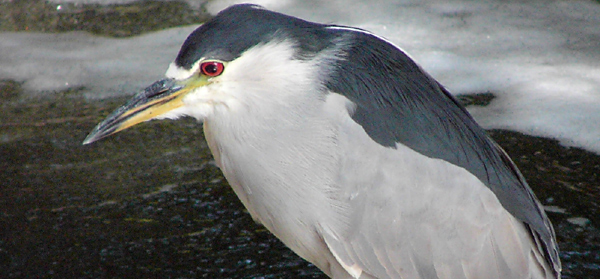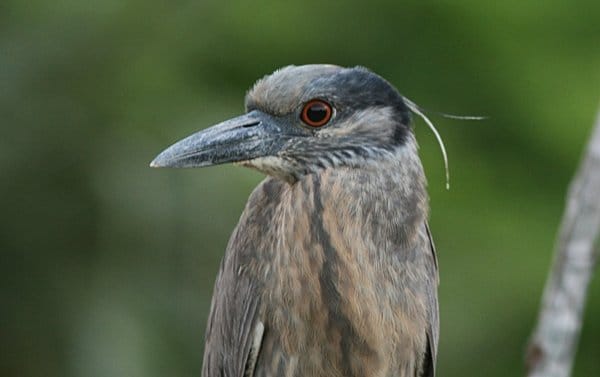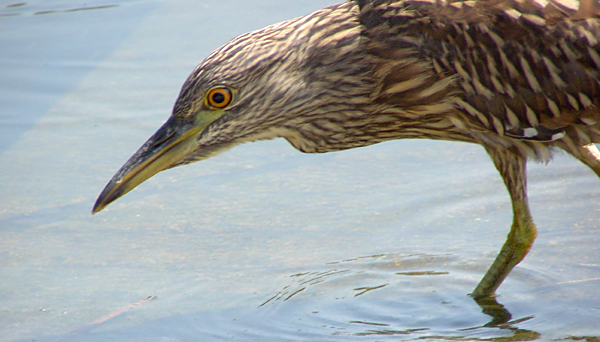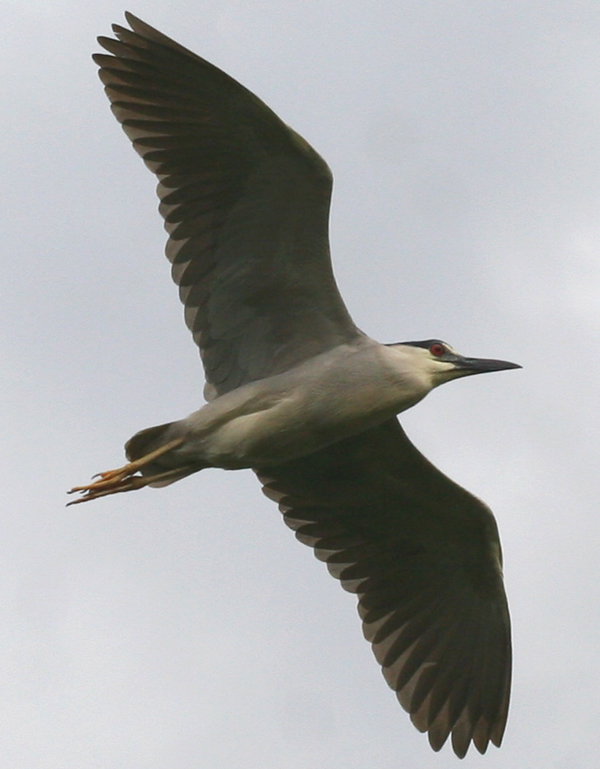Eerie. Sinister. Unnaturally still. These are apt descriptions for those wondrous waders, the night herons. These stout birds of the genera Nycticorax and Gorsachius (Family Ardeidae) resemble feathered footballs tastefully appointed in gray and white. However, their hunched posture and nocturnal habits lend night herons a baleful mien.
Adding to the night heron’s ominous aspect is its particular method of hunting. These omnivores enjoy a wide variety of foods; fish, amphibians, reptiles, crustaceans, insects, other birds, plant matter, and even small mammals are all fair game.They stalk aquatic prey by standing motionless for hours on end in or by shallow water, then striking with dagger sharp bills. This tactic, called still fishing, must be effective, as these adaptable birds can be found in nearly any terrain as long as water is nearby. The Black-crowned Night Heron (Nycticorax nycticorax) also employs another hunting technique called bill vibrating, whereby it opens and closes its bill rapidly in water and preys upon any small creature attracted to the disturbance.

Black-crowned Night Heron by Mike Bergin
The Black-crowned Night Heron is the poster child for the night heron family. Nycticorax nycticorax literally means “night raven, night raven” in the original Greek. The first part of this bird’s scientific name is fitting, as the black-crown is, in the way of night-herons, nocturnal, hunting at dusk and dawn while idling during daytime hours. The second half of the name does not denote any relation to the family Corvidae; this bird is a long-legged wader through and through. The similarity between a night heron and a raven is purely vocal. The black-crown is known, though not loved, for its noisy, croaking cry, depicted as “Quark!” or “Quawk!” This guttural call at dusk can be somewhat distressing. The black-crowned night-heron is fairly common throughout the United States. Though it is a solitary hunter, this bird is rather gregarious and breeds in colonies. The black-crown’s range far exceeds North America, extending from Europe, where it is known simply as the Night Heron, to Asia and down through India to Africa.
The Yellow-crowned Night Heron (Nycticorax violaceus) shares the Americas with the black-crown. It also shares a piercing crimson glare and striated brown juvenile plumage, the latter a feature of all night heron species. The yellow-crown is fairly common in appropriate habitat throughout its range, as is the Nankeen (or Rufous) Night Heron, (Nycticorax caledonicus) of Australasia, Indonesia, and the Philippines.

Juvenile Yellow-crowned Night Heron by Mike Bergin
Other night heron species aren’t as robust. The Malayan (or Malaysian) Night Heron (Gorsachius melanolophus) of southern and eastern Asia, known also as the Tiger Bittern, is widespread throughout its range, but still considered threatened. Africa’s White-backed Night Heron (Nycticorax leuconotus) isn’t that easy to spot either. But these birds have nothing on the poor, endangered Japanese Night Heron (Gorsachius goisagi) whose current population has dwindled down to about 1,000 in only a few decades. Even worse is the plight of the White-eared Night Heron (Gorsachius magnificus) a Chinese bird listed on the IUCN Red List as one of the world’s most endangered species. The white-ear even made the list of the Fifty Rarest Birds of the World, a dubious honor indeed.
Yet, any extant Night Heron can deem itself fortunate in comparison to the former Nycticorax natives of Ascension Island, Bermuda, and the Mascarene Islands of Mauritius, Reunion, and Rodrigues. Each of these five locations once hosted its own endemic night heron, now extinct.















I have both the Black & Yellow Night Herons living right in the woods behind my house, where we have swamps/wetlands. Stop by anytime to watch them in action. Last year, we had these brown speckled birds in our yard, eating birdfood that I put outside for the wild birds. At first we thought they were pheasants, but upon doing research tonight, I realize that what they really are is the Black Night Heron’s babies!
I saw what I belieseve was a yellow crowned night heron
at Barnegat Light,N.J. on 08/22/2010…I was unable to get a photo on my cell…but I quite sure that is what it was…..Are these birds seen in coastal NJ?
I believe they are, Alex.
Geelong has some lovely Nankeens worth viewing ive seen them eat large fish on the Barwon River pity city council dont do much to protect them but i guess its hard to do so when you are the home of the Cats.
I thought most Herons in Florida stay in the wetlands but we have a green heron that hangs out here on our salt water canal and for the past several nights, we have had a bird I can’t identify that in some ways matches the behavior of a heron but…not sure due to the very slim body. Description as follows: Very slender, long legs, long straight beak, brownish color with a high reddish(?)crown and horizontal stripe on head. I was told it purches on the dock posts but what was interesting was watching it hunt and move very quickly across the lawn. The green heron will wait below the trees when hunting and this bird was darting in and out of the bushes. The green heron was much more stout but this bird had long legs but was smaller than the limpkins/Egrets/Ibsis that visit often. Any idea? On another note – waiting for our guava tree berries to turn red so that the green parrots come back to chomp…a few weeks perhaps.
I have been watching a small group of black crested night heron near my home in San Jose. There has been any where from 1-6 (sometimes more) out on the lawn of a school near me. They are so Odd but beautiful at the same time. I have been obsessed with watching them and the juveniles walk around the lawn. There is no water in the close vicinity where they are , so what is the draw for the lawn? I watch them snap up something but it’s too dark for me to see up close. Grubs maybe? I will drive by at least 5 nights a week and check on them. There are only a few left as they have moved on to somewhere else lately. Can anyone tell me why the lawns of this school when lake Vasona in Los Gatos is not too far from here if they’re supposed to be waders? I will miss them when they’ve all flown off to different parts :((
This heron keeps on attacking my koi fry. iliminate him even if I get pity because if I will not get rid of him all my koi fry are eaten